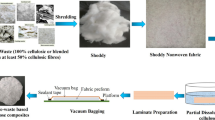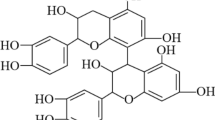Abstract
Worldwide, 45 million tons of waste cotton textiles are produced annually, of which 75% is burned and buried, leading to serious environmental pollution. In this study, a method for directly preparing colored regenerated cellulose fibers (CRCFs) from dyed cotton textile waste (DCTW) was demonstrated. The tensile strength of CRCFs reached 226 MPa, which was equivalent to that of commercial viscose fibers. CRCFs exhibited excellent color fastness and hydrophilicity. In addition, CRCFs can be reprocessed into secondary CRCFs. The tensile strength of secondary CRCFs was 14.64% less than that of the primary CRCFs due to the reduction in the polymerization degree of secondary CRCFs; however, it also can be woven into fabrics. The exploration of the secondary utilization of CRCFs provides an experimental basis for prolonging the service life of DCTW. This approach of preparing CRCFs achieves closed-loop recycling of waste colored cellulose textiles and prevents environmental pollution caused by decoloring and dyeing.









Similar content being viewed by others
References
Burton K (2018) Reducing textile waste in the apparel industry: examining EPR as an option. Cloth Cult 5(1):33–45. https://doi.org/10.1386/cc.5.1.33-1
Chapagain AK, Hoekstra AY, Savenije H, Gautam R (2007) The water footprint of cotton consumption: an assessment of the impact of worldwide consumption of cotton products on the water resources in the cotton producing countries. Ecol Econ 60(1):186–203. https://doi.org/10.1016/j.ecolecon.2005.11.027
Chen L, Wang B, Ruan X, Chen J, Yang Y (2015) Hydrolysis-free and fully recyclable reactive dyeing of cotton in green, non-nucleophilic solvents for a sustainable textile industry. J Clean Prod 107:550–556. https://doi.org/10.1016/j.jclepro.2015.05.144
Dassanayake RS, Dissanayake N, Fierro JS, Abidi N, Quitevis EL, Boggavarappu K, Thalangamaarachchige VD (2021) Characterization of cellulose nanocrystals by current spectroscopic techniques. Appl Spectrosc Rev. https://doi.org/10.1080/05704928.2021.1951283
De Silva R, Byrne N (2017) Utilization of cotton waste for regenerated cellulose fibres: influence of degree of polymerization on mechanical properties. Carbohydr Polym 174:89–94. https://doi.org/10.1016/j.carbpol.2017.06.042
Fan W, Zhang G, Zhang X, Dong K, Liang X, Chen W, Yu L, Zhang Y (2022) Superior unidirectional water transport and mechanically stable 3D orthogonal woven fabric for human body moisture and thermal management. Small 18:e2107150. https://doi.org/10.1002/smll.202107150
French AD (2014) Idealized powder diffraction patterns for cellulose polymorphs. Cellulose 21:885–896. https://doi.org/10.1007/s10570-013-0030-4
French AD (2020) Increment in evolution of cellulose crystallinity analysis. Cellulose 27:5445–5448. https://doi.org/10.1007/s10570-020-03172-z
Haslinger S, Wang Y, Rissanen M, Lossa MB, Tanttu M, Ilen E, Määttänen M, Harlin A, Humme M, Sixta H (2019) Recycling of vat and reactive dyed textile waste to new colored man-made cellulose fibers. Green Chem 21:5598–5610. https://doi.org/10.1039/c9gc02776a
Haule LV, Carr CM, Rigout M (2016) Preparation and physical properties of regenerated cellulose fibres from cotton waste garments. J Clean Prod 112:4445–4451. https://doi.org/10.1016/j.jclepro.2015.08.086
Kasavan S, Yusoff S, Guan NC, Zaman NSK, Fakri MFR (2021) Global trends of textile waste research from 2005 to 2020 using bibliometric analysis. Environ Sci Pollut Res 28(33):44780–44794. https://doi.org/10.1007/s11356-021-15303-5
Lei L, Lindbrathen A, Sandru M, Gutierrez MTG, Zhang X, Hillestad M, He X (2018) Spinning cellulose hollow fibers using 1-ethyl-3-methylimidazolium acetate-dimethylsulfoxide co-solvent. Polymers 10(9):972. https://doi.org/10.3390/polym10090972
Li J, Lu S, Liu F, Qiao Q, Na H, Zhu J (2021) Structure and properties of regenerated cellulose fibers based on dissolution of cellulose in a CO2 switchable solvent. ACS Sustain Chem Eng 9:4744–4754. https://doi.org/10.1021/acssuschemeng.0c08907
Liu W, Liu S, Liu T, Liu T, Zhang J, Liu H (2018) Eco-friendly post-consumer cotton waste recycling for regenerated cellulose fibers. Carbohydr Polym 206:141–148. https://doi.org/10.1016/j.carbpol.2018.10.046
Lu L, Fan W, Meng X, Liu T, Han L, Zhang T, Tian H (2020) Modal analysis of 3D needled waste cotton fiber/epoxy composites with experimental and numerical methods. Text Res J 91(3–4):358–372. https://doi.org/10.1177/0040517520944477
Ma Y, Zeng B, Wang X, Byrne N (2019) Circular textiles: closed loop fiber to fiber wet spun process for recycling cotton from denim. ACS Sustain Chem Eng 7(14):11937–11943. https://doi.org/10.1021/acssuschemeng.8b06166
Mendes ISF, Prates A, Evtuguin DV (2021) Production of rayon fibres from cellulosic pulps: state of the art and current developments. Carbohydr Polym 273:118466. https://doi.org/10.1016/j.carbpol.2021.118466
Meng X, Fan W, Wan Mahari WA, Ge S, Xia C, Wu F, Lam SS (2021) Production of three-dimensional fiber needle-punching composites from denim waste for utilization as furniture materials. J Clean Prod 281:125321. https://doi.org/10.1016/j.jclepro.2020.125321
Muthu SS (2014) The textile supply chain and its environmental impact. In: Muthu SS (ed) Assessing the environmental impact of textiles and the clothing supply chain. Woodhead Publishing, Sawston, pp 1–31. https://doi.org/10.1533/9781782421122.1
Ning XA, Lin MQ, Shen LZ, Zhang JH, Wang JY, Wang YJ (2014) Levels, composition profiles and risk assessment of polycyclic aromatic hydrocarbons (PAHs) in sludge from ten textile dyeing plants. Environ Res 132:112–118. https://doi.org/10.1016/j.envres.2014.03.041
Olsson C (2013) Wet spinning of cellulose from ionic liquid solutions–viscometry and mechanical performance. J Appl Polym Sci 127(6):4542–4548. https://doi.org/10.1002/app.38064
Palacios-Mateo C, Yvonne VDM, Seide G (2021) Analysis of the polyester clothing value chain to identify key intervention points for sustainability. Environ Sci Eur 33(1):1–25. https://doi.org/10.1186/s12302-020-00447-x
Palme A, Idström A, Nordstierna L, Brelid H (2014) Chemical and ultrastructural changes in cotton cellulose induced by laundering and textile use. Cellulose 21(6):4681–4691. https://doi.org/10.1007/s10570-014-0434-9
Ren J, Liang H, Chan FTS (2017) Urban sewage sludge, sustainability, and transition for Eco-City: multi-criteria sustainability assessment of technologies based on best-worst method. Technol Forecast Soc Chang 116:29–39. https://doi.org/10.1016/j.techfore.2016.10.070
Sezgin H, Kucukali-Ozturk M, Berkalp OB, Yalcin-Enis I (2021) Design of composite insulation panels containing 100% recycled cotton fibers and polyethylene/polypropylene packaging waste. J Clean Prod 304:127132. https://doi.org/10.1016/j.jclepro.2021.127132
Turemen M, Demir A, Ozdogan E (2019) Recycling and importance for textile industry. Pamukkale Univ J Eng Sci-Pamukkale Universitesi Muhendislik Bilimleri Dergisi 25(7):805–809. https://doi.org/10.5505/pajes.2018.97253
Wang S, Zhang T, Zhang X, Ge S, Fan W (2022) Development of 3D needled composite from denim waste and polypropylene fibers for structural applications. Constr Build Mater 314:125583. https://doi.org/10.1016/j.conbuildmat.2021.125583
Weber S, Lynes J, Young SB (2017) Fashion interest as a driver for consumer textile waste management: reuse, recycle or disposal. Int J Consum Stud 41(2):207–215. https://doi.org/10.1111/ijcs.12328
Wedin H, Niit E, Mansoor ZA, Kristinsdottir AR, Hanna D, Jonsson C, Lindgren C (2018) Preparation of viscose fibres stripped of reactive dyes and wrinkle-free crosslinked cotton textile finish. J Polym Environ 26(9):3603–3612. https://doi.org/10.1007/s10924-018-1239-y
Wu GH, Wang LL, Ding XM, Wu XY, Cuc S (2015) Water footprint and carbon footprint reduction in textile’s waste recycling. Ind Text 66(2):85–89
Wu Y-L, Yao L, Geng A-Y (2016) A study on the operating mechanism of waste textile’s recycling and reusing system in Germany. In: Textile bioengineering and informatics symposium/6th Asian protective clothing conference, pp 895–902
Yao WQ, Weng YY, Catchmark JM (2020) Improved cellulose X-ray diffraction analysis using Fourier series modeling. Cellulose 27:5563–5579. https://doi.org/10.1007/s10570-020-03177-8
Yousef S, Tatariants M, Tichonovas M, Sarwar Z, Jonuškienė I, Kliucininkas L (2019) A new strategy for using textile waste as a sustainable source of recovered cotton. Resour Conserv Recycl 145:359–369. https://doi.org/10.1016/j.resconrec.2019.02.031
Yu X, Fan W, Azwar E, Ge S, Xia C, Sun Y, Lam SS (2021) Twisting in improving processing of waste-derived yarn into high-performance reinforced composite. J Clean Prod 317:128446. https://doi.org/10.1016/j.jclepro.2021.128446
Zhen L, Hui W, Li Z, Lu X, Zhou K (2011) Rheological properties of cotton pulp cellulose dissolved in 1-butyl-3-methylimidazolium chloride solutions. Polym Eng Sci 51(12):2381–2386. https://doi.org/10.1002/pen.22010
Zhou Y, Lu J, Zhou Y, Liu Y (2019) Recent advances for dyes removal using novel adsorbents: a review. Environ Pollut 252:352–365. https://doi.org/10.1016/j.envpol.2019.05.072
Funding
The authors acknowledge the financial support from National Natural Science Foundation of China (No. 52073224), Textile Vision Basic Research Program of China (No. J202110), Advanced Manufacturing Technology Project of Xi’an Science and Technology Bureau (No. 21XJZZ0019), Key Research and Development Program of Xianyang Science and Technology Bureau, China (No. 2021ZDYF-GY-0035), Natural Science Foundation of Shaan Province, China (No. 2021JQ-685), Key Research and Development Program of Shaanxi Province, China (No. 2022SF-470, 2022GY-377, 2022GY-283), the China Postdoctoral Science Foundation (2021M690847), National Natural Science Foundation of China (31901372), and Natural Science Foundation of Jiangsu Province (BK20200775 and BK20190758), Scientific Research Project of Shaanxi Provincial Education Department, China (No. 22JC035).
Author information
Authors and Affiliations
Contributions
HL: conceptualization, methodology, data curation, formal analysis, investigation, writing—original draft. WF: conceptualization, project administration, resources, visualization, conceptualization, validation, writing—review and editing. YM: methodology, data curation, formal analysis, investigation. HD: visualization, conceptualization, validation. YS: validation. SW: visualization, validation. XZ: formal analysis. LH: validation. XY: conceptualization. SSL: formal analysis. SG: data curation, investigation.
Corresponding author
Ethics declarations
Conflict of interest
The authors have no relevant financial or non-financial interests to disclose.
Additional information
Publisher's Note
Springer Nature remains neutral with regard to jurisdictional claims in published maps and institutional affiliations.
Rights and permissions
Springer Nature or its licensor (e.g. a society or other partner) holds exclusive rights to this article under a publishing agreement with the author(s) or other rightsholder(s); author self-archiving of the accepted manuscript version of this article is solely governed by the terms of such publishing agreement and applicable law.
About this article
Cite this article
Liu, H., Fan, W., Miao, Y. et al. Closed-loop recycling of colored regenerated cellulose fibers from the dyed cotton textile waste. Cellulose 30, 2597–2610 (2023). https://doi.org/10.1007/s10570-022-05002-w
Received:
Accepted:
Published:
Issue Date:
DOI: https://doi.org/10.1007/s10570-022-05002-w




